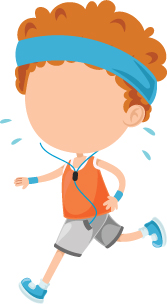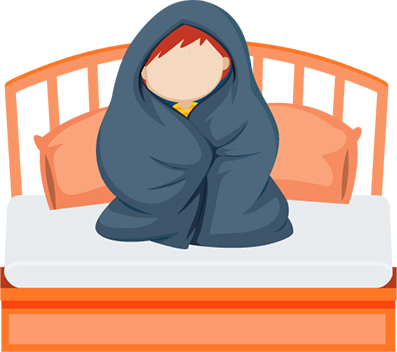We’re so excited to share some sleep advice from our friends at the Sleep Advisor. This week, we have a guest blogger Mark Mattei sharing his guide to a child’s better sleep.
Here’s a little more about Mark:
Sleep is something I like to do, A LOT. So if I’m not writing about or researching sleep-related topics you can probably find me in my bed catching some Zzz’s. When I’m awake, I love to spend time outdoors with my family. Hiking, camping, snowboarding, and riding ATVs are among the many activities we like to do. My wish for my readers is that they can find answers to their sleep-related questions, so they too can live an active and healthy lifestyle when they’re not in bed.

Our parent’s guide to healthy sleep habits can help you and your children achieve the rest you deserve. We go over some of the problems parents are facing and some common and highly researched solutions.
But before we dive in, it might be comforting to know you are not alone in your endeavors.
50 percent of children have problems sleeping at some time during their childhood, says Zheng (Jane) Fan, MD, of the UNC Department of Neurology.
Before we can realize the full extent of childhood nighttime problems, we need to know how much rest our kiddos need.

Sleep Problems and Solutions for Infants and Toddlers
If babies and toddlers need to rest so much, why do so many of them put up such a fuss at night?
There are several reasons why our kids might not want to fall asleep. In the case of my two-year-old daughter, she finds a pair of dirty socks stuffed behind her bed more entertaining than the back of her eyelids. And can you really blame her?
These babies and toddlers often spend all day with their parents and are then expected to spend 8 to 10 hours alone. This can cause anxiety, fear, boredom, hunger, etc. The list goes on, but let’s cover the most common reasons.




General Sleep Solutions
Whatever the issue may be. There are several possible solutions that can help get you and your kiddo the rest you deserve.
Studies show this is true for both adults and children. Setting and sticking to a habitual schedule can prepare you for bedtime.

Example
My toddler’s bedtime routine is more in-depth, as this is what our daughter typically needs to fall asleep, so feel free to adjust this as you feel necessary.
We first eat a yummy dinner, pop bubbles in the bath, brush her teeth, put on cozy pajamas, pick up her toys, read a story (or 5), sing a fun song, tuck her snugly into bed, and she’s off to dreamland (hopefully). And that typically does the trick!
A routine for an older child could be, bathe, brush teeth, read a book, and fall asleep.
“Sleep associations are incredibly strong. The repetitive nature of a parent’s exact actions before bed… are very powerful.”
[16] National Sleep Foundation
A messy bedroom naturally calls children to come out and play. If they can see it, whether it be your toddler’s choo-choo train or your teenager’s Nintendo Switch, if the plaything is visible then it is a viable play option. With your child’s help, clean up each night and put the toys in a secure location, like a toy chest or closet where they should not be a distraction.
Though the room should be kept dark and toys not readily accessible, it is okay for a child to hold onto a security item, like a stuffed animal or blanket.
“It is fine to allow security objects, such as a special blanket or stuffed animal, to be a part of the bedtime routine.”
Sometimes our kids are not ready to go to bed when we want them to be. Trim back their nap times, this should help them get tired just a bit earlier.
“If your child isn’t tired at bedtime, you might be fighting a losing battle. Try scaling back on any daytime naps.”
A daily workout can wear out your body so you are ready to hit the bed come night time. Children don’t need a gym membership to do this either. Toddlers simply need some time to crawl around, run, or dance, and older children can supplement a workout with sports, playing outside, or other recreational activities.
Though exercise is great, children should avoid it directly before bed. The body releases endorphins that can excite and energize your child’s mind, keeping them from sleeping. Best to schedule exercise at the latest 2 hours before bed.

“The obvious, widely recognized, and commonly self-realized sleep quality improvements associated with exercise has lead to adopting the canon “maintain a regular exercise program” as one of the veritable 10-commandments of sleep.”
Pediatric Sleep Disorders
If you’ve tried these solutions and shuteye continues to evade your child, it may be time to get them in to see their medical practitioner. You may even have some more serious concerns that require a doctor visit. When it comes to medical problems, nothing truly beats the hands-on experience a doctor can provide.

Sleepwalking
This is a type of parasomnia, an undesired nighttime behavior, and can quickly become a serious concern as children can fall and seriously hurt themselves or someone else.
Night Terrors
Often result in screaming and thrashing while asleep. This differs from nightmares, as the sleeper remains asleep during their episode.
Insomnia
This condition makes it hard for sleepers to not only fall asleep, but it also makes it very difficult to stay asleep. Children who suffer from insomnia often experience a continuous feeling of sleepiness.
Hypersomnia
This condition causes patients to have a hard time staying awake during the day. These children report being able to fall asleep at just about any time.
Sleep Apnea
This condition causes sleepers to have “mini awakenings” that are caused by a respiratory disruption while sleeping. Causing them to not get a truly restorative nights’ rest.
Delayed Sleep Phase Disorder
This condition causes patients to consistently wake and rise in an overly delayed schedule to normal solar wake and sleep cues. They fall asleep late and rise later in the morning than the average sleeper.
Circadian Rhythm Disorder
These conditions affect the body’s internal clock. People with this disorder often do not follow the most socially accepted times to be awake and sleep. These are your night owls and larks.
Frequently Asked Questions
When is it okay for my kid to take a nap?
Kids are okay to take a nap, especially from 0 months to 5 years old. As children get older they should typically nap less if they are on a healthy sleep schedule. A 30 to 90-minute nap could potentially be beneficial for older children if they live an active lifestyle.
What happens if your child doesn’t get enough sleep?
Toddlers: Could potentially have too much energy.
Children: Decreased awareness, bad mood, and poor academic performance.
Teenagers: Irritability and frequent mood changes.
Lead by Example
Parents, let’s face it. We need to rest, too. The best way to get it may be by showing our youngsters how.
- Show your kids that you have your own bedtime routine. They will likely recognize this and apply parts of it to their own schedule.
- Try having a full-blown technology shut down before bed. This can show your kids that this is something you just don’t do before bed.
- Do your best to have a consistent bedtime. As you establish this habit, it will make it that much easier to enforce your child’s bedtime because you will likely be feeling pretty tired soon after you tuck your kid in.
- Anything you can do, your kids can do better. Try to avoid all-nighters. If they hear you up watching Netflix at 2 a.m., they’re going to want to join in on the fun.
Conclusion
Children of all ages struggle to get adequate sleep and whether your child is in diapers or getting ready to head off to college, you should now have some tools to help him or her get some rest.
Go ahead. Give these things a try and if you find success be sure to share this info with friends and family. Hopefully as our kids begin to get sleep more, we can get more sleep too.
Sources and References and more information can be found on the Sleep Advisor here.